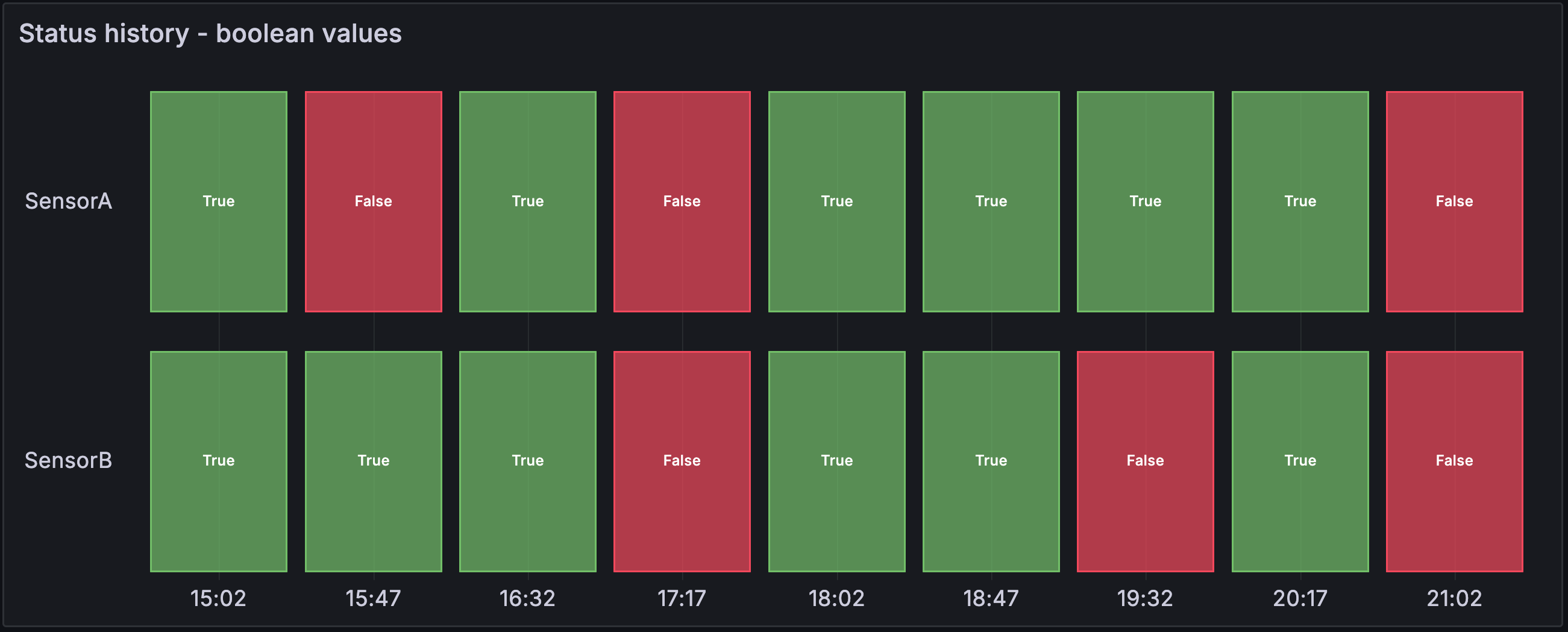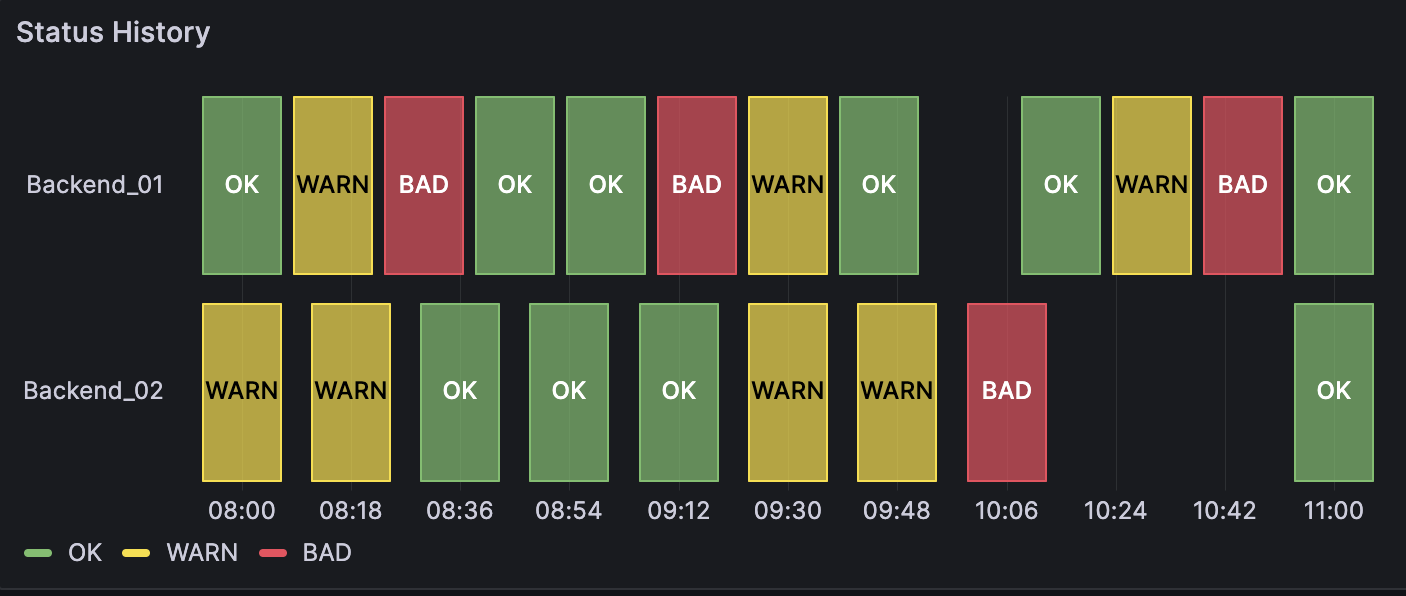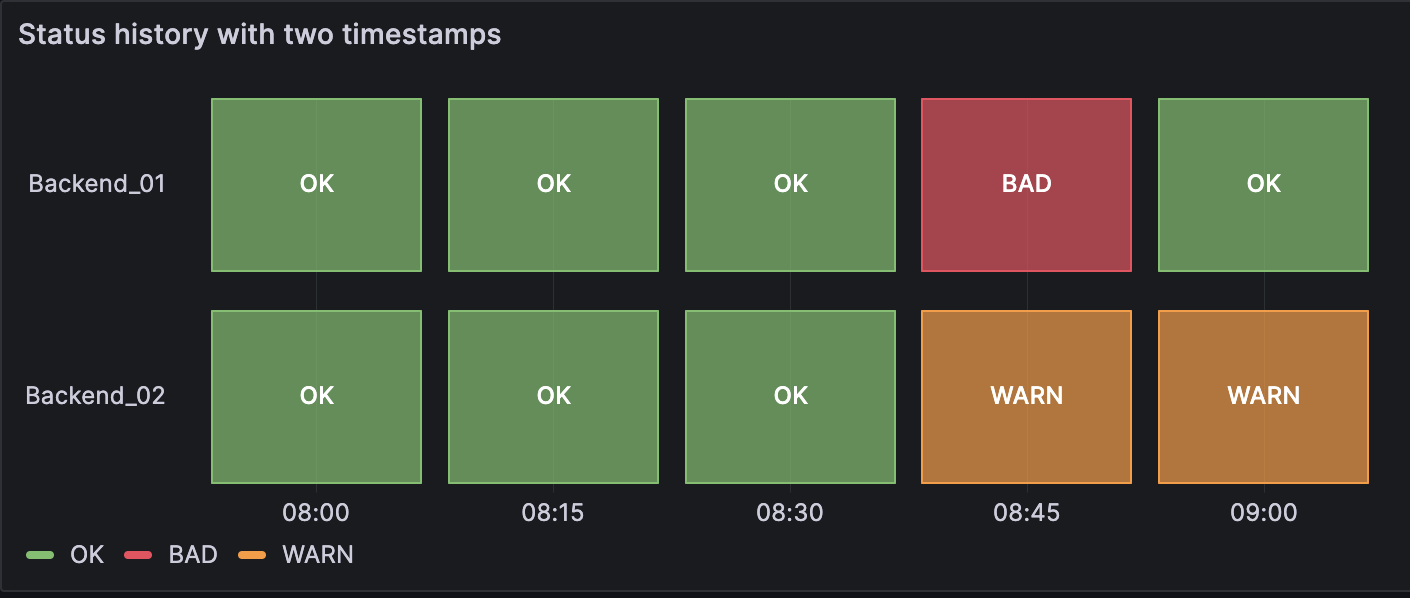Status history
A status history visualization displays data in a way that shows periodic states over time. In a status history, each field or series is rendered as a horizontal row, with multiple boxes showing the different statuses. This provides you with a centralized view for the status of a component or service.
For example, if you’re monitoring the health status of different services, you can use a status history to visualize the different statuses, such as “True” or “False,” over time. Each status is represented by a different color:

Note
A status history is similar to a state timeline, but has different configuration options. Unlike state timelines, status histories don’t merge consecutive values.
Use a status history when you need to:
- Monitor the status of a server, application, or service to know when your infrastructure is experiencing issues over time.
- Identify operational trends over time.
- Spot any recurring issues with the health of your applications.
Configure a status history
Once you’ve created a dashboard, you can use the following state timeline video as a reference for how to configure a status history:
With Grafana Play, you can explore and see how it works, learning from practical examples to accelerate your development. This feature can be seen on Grafana State Timeline & Status History.
Supported data formats
The status history visualization works best if you have data capturing the various status of entities over time, formatted as a table. The data must include:
- Timestamps - Indicate when each status change occurred. This could also be the start time for the status change. You can also add an optional timestamp to indicate the end time for the status change.
- Entity name/identifier - Represents the name of the entity you’re trying to monitor.
- Status value - Represents the state value of the entity you’re monitoring. These can be string, numerical, or boolean states.
Examples
The following tables are examples of the type of data you need for a status history visualization and how it should be formatted.
Single time column with null values
The data is converted as follows, with the null and empty values visualized as gaps in the status history:

Two time columns without null values
The data is converted as follows:

Zoom panel time range
You can zoom the panel time range in and out, which in turn, changes the dashboard time range.
Zoom in - Click and drag on the panel to zoom in on a particular time range.
Zoom out - Double-click anywhere on the panel to zoom out the time range.
When you zoom out, the range doubles with each double-click, adding equal time to each side of the range. For example, if the original time range is from 9:00 to 9:59, the time range changes as follow with each double-click:
- Next range: 8:30 - 10:29
- Next range: 7:30 - 11:29
For screen recordings showing these interactions, refer to the Panel overview documentation.
Configuration options
The following section describes the configuration options available in the panel editor pane for this visualization. These options are, as much as possible, ordered as they appear in Grafana.
Panel options
In the Panel options section of the panel editor pane, set basic options like panel title and description, as well as panel links. To learn more, refer to Configure panel options.
Status history options
Use these options to refine the visualization.
Legend options
When the legend option is enabled it can show either the value mappings or the threshold brackets. To show the value mappings in the legend, it’s important that the Color scheme as referenced in Color scheme is set to Single color or Classic palette. To see the threshold brackets in the legend set the Color scheme to From thresholds.
For more information about the legend, refer to Configure a legend.
Visibility
Toggle the switch to turn the legend on or off.
Mode
Use these settings to define how the legend appears in your visualization.
- List - Displays the legend as a list. This is a default display mode of the legend.
- Table - Displays the legend as a table.
Placement
Choose where to display the legend.
- Bottom - Below the graph.
- Right - To the right of the graph.
Width
Control how wide the legend is when placed on the right side of the visualization. This option is only displayed if you set the legend placement to Right.
Tooltip options
Tooltip options control the information overlay that appears when you hover over data points in the visualization.
Tooltip mode
When you hover your cursor over the visualization, Grafana can display tooltips. Choose how tooltips behave.
- Single - The hover tooltip shows only a single series, the one that you are hovering over on the visualization.
- All - The hover tooltip shows all series in the visualization. Grafana highlights the series that you are hovering over in bold in the series list in the tooltip.
- Hidden - Do not display the tooltip when you interact with the visualization.
Use an override to hide individual series from the tooltip.
Values sort order
When you set the Tooltip mode to All, the Values sort order option is displayed. This option controls the order in which values are listed in a tooltip. Choose from the following:
- None - Grafana automatically sorts the values displayed in a tooltip.
- Ascending - Values in the tooltip are listed from smallest to largest.
- Descending - Values in the tooltip are listed from largest to smallest.
Axis options
Standard options
Standard options in the panel editor pane let you change how field data is displayed in your visualizations. When you set a standard option, the change is applied to all fields or series. For more granular control over the display of fields, refer to Configure overrides.
To learn more, refer to Configure standard options.
Data links and actions
Data links allow you to link to other panels, dashboards, and external resources and actions let you trigger basic, unauthenticated, API calls. In both cases, you can carry out these tasks while maintaining the context of the source panel.
For each data link, set the following options:
- Title
- URL
- Open in new tab
- One click - Opens the data link with a single click. Only one data link can have One click enabled at a time.
For each action, define the following API call settings:
To learn more, refer to Configure data links and actions.
Value mappings
Value mapping is a technique you can use to change how data appears in a visualization.
For each value mapping, set the following options:
- Condition - Choose what’s mapped to the display text and (optionally) color:
- Value - Specific values
- Range - Numerical ranges
- Regex - Regular expressions
- Special - Special values like
Null,NaN(not a number), or boolean values liketrueandfalse
- Display text
- Color (Optional)
- Icon (Canvas only)
To learn more, refer to Configure value mappings.
Thresholds
A threshold is a value or limit you set for a metric that’s reflected visually when it’s met or exceeded. Thresholds are one way you can conditionally style and color your visualizations based on query results.
For each threshold, set the following options:
To learn more, refer to Configure thresholds.
Field overrides
Overrides allow you to customize visualization settings for specific fields or series. When you add an override rule, it targets a particular set of fields and lets you define multiple options for how that field is displayed.
Choose from the following override options:
To learn more, refer to Configure field overrides.



